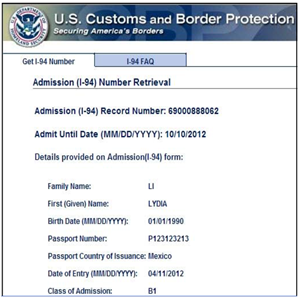 Many visitors and medium-term residents of the US are at some point confused by Form I-94, the US government’s method of tracking arrivals and departures by foreign non-immigrants.
Many visitors and medium-term residents of the US are at some point confused by Form I-94, the US government’s method of tracking arrivals and departures by foreign non-immigrants.
| We offer U.S. immigration consultations to clients worldwide. Contact us here to schedule a consultation. |
An I-94 is issued upon entry to the United States with a non-immigrant visa (such as a B, E, F, H, J, L, or O visa). Holders of US passports, green cards, and immigrant visas, as well as travelers under the Visa Waiver Program (using ESTA), do not receive an I-94. In case of entry through a land border with Canada or Mexico, the traveler fills out an I-94 form on paper and has it stamped by the Customs and Border Protection (CBP) officer at the port of entry. Otherwise, unless CBP is asked to provide a paper I-94 at the time of arrival in the US, the I-94 is issued electronically and can only be checked by going to a CBP website.
 Sample electronic I-94
Sample electronic I-94
Always Check the “Admit Until Date”
EVERY traveler with an I-94 should check its “Admit Until Date” as soon as possible. This date is the traveler’s deadline to either leave the United States, or extend or change their status. In many cases, this is NOT the same as the expiration date of the visa, which only determines when the visa holder may enter the United States. For example, B-1 and B-2 visa holders usually (but not always) have an “Admit Until Date” that is six months after the date of entry, and E-1 and E-2 visa holders usually (but not always) have an “Admit Until Date” that is two years after the date of entry, regardless of when their visa expires. F-1 and J-1 visa holders are usually admitted for “D/S” (“duration of status”), allowing them to remain in the United States as long as they remain enrolled in their program and otherwise comply with the terms of their visa.
The “Admit Until Date” may be shorter than expected, and is at the discretion of the CBP officer at the port of entry, so it is always important to double-check.
Correcting an Error
CBP officers sometimes input incorrect information, such as an incorrect name, nationality, or entry date, or an unreasonably short “Admit Until Date.” In many cases, the easiest way to correct these errors is to visit a CBP Deferred Inspection Site at an international airport, border crossing, or seaport.
Renewing an I-94 by Traveling Abroad
A holder of a multiple-entry visa such as a B, E, or O visa can obtain a new I-94 by leaving the United States for a short trip. Some care is required when traveling to Canada or Mexico, as returning from short trips to these countries (especially through the land border) will not always result in a new I-94 being generated. CBP has a procedure known as “automatic revalidation” to allow holders of expired visas to take short trips to Canada and Mexico and then re-enter the US on their existing I-94. Travelers who actually wish to get a new I-94, such as E and O visa holders who want an extended period of stay, should be careful to ensure that CBP issues one.
Extending an I-94 Within the United States
Most I-94 extensions are processed through U.S. Citizenship and Immigration Services (USCIS). Employment-based visas generally require a Form I-129 to be submitted by the employer (essentially similar to what is submitted when applying for a new visa), while non-employment-based visas (including visas for dependents of employment-based visa holders) generally require a Form I-539 to be submitted by the visa holder. If USCIS approves the extension, it will issue a new electronic I-94.
CBP may extend an I-94 “Admit Until Date” if it is related to an error by CBP at the time of admission, such as the CBP officer issuing an unusually short “Admit Until Date.” This process may be much easier and faster than requesting an extension through USCIS.